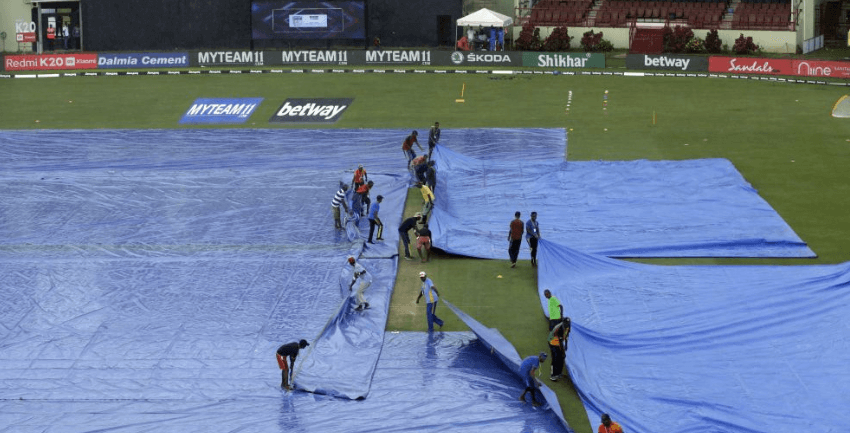Let’s start by talking about the DLS method, which is like a magical math trick that helps keep cricket matches fair when rain keeps interrupting the game. In cricket, rain often shows up unexpectedly and messes things up, making it hard to finish a match properly.
Imagine this: you’re all set to enjoy a cricket match, but then rain shows up, and the game has to pause. You find yourself huddled under an umbrella, trying to keep your snacks dry, while the players reluctantly leave the field. The players might even have some fun sliding around on the wet field. It’s in these moments when you wonder if the people who came up with the DLS method had a genius idea to make cricket more fair during these rainy days.
Table of Contents
Rainy Days and Cricket Matches: A Love-Hate Story
Imagine: You’ve got your snacks ready, that comfy spot on the couch claimed, and a day of cricketing excitement ahead of you. You’re ready to support your favorite team, but right before the players step onto the field, rain begins to fall! It’s like Mother Nature’s way of saying, ‘Sorry, folks, cricket is canceled today!’
As cricket fans, we’ve all experienced that, right? The frustration, the impatience, the disappointment of watching the rain pour down while we just wish it would make way for some good old cricketing action. But let’s not forget those memorable moments when rain decided to take center stage in the cricketing drama. Who can forget the 1992 World Cup semi-final, when South Africa needed 22 runs from 13 balls against England, only for rain to intervene and leave everyone scratching their heads? Or the unforgettable 2002 NatWest Series final between India and England, where Sourav Ganguly celebrated shirtless on the Lord’s balcony after a rain-affected victory?
In the modern era, we have the Duckworth-Lewis-Stern (DLS) method to make sense of these rain-induced disruptions. It’s like cricket’s own version of the ‘Chai pe Charcha.’ DLS Method, with its mathematical wizardry, comes to the rescue, ensuring that matches remain fair and square, even when rain tries to pull a fast one.
Imagine you’re watching a big India-Pakistan cricket match, and it starts raining. Your grandma, who’s been watching the game with you, suddenly starts dancing in the rain to try and make it stop. You can’t help but smile at her funny and unexpected move, while hoping that her dance might somehow bring good luck to your team. In cricket, sometimes even the craziest things can make a difference!

Origins of DLS Method: The Math Behind Cricket Rain Delay
Let’s rewind to when cricket matches faced a rainy-day dilemma. Imagine your favorite sport getting interrupted by showers – that’s no fun! But in came three cricket-loving numbers guys: Frank Duckworth, Tony Lewis, and Steve Stern.
They were like the math wizards of cricket, and one day, while probably having tea, they had a genius idea. They thought, “Hey, why don’t we create a method to deal with rain delays in cricket matches?” And that’s how the DLS method was born.
So, think of it like this: cricket got its very own superhero trio who used math to save the day. Now, when rain threatens to spoil the game, the DLS method steps in and keeps things fair. It’s like a secret plan to make sure cricket matches are exciting no matter what the weather is doing. Even if you’re not a cricket pro, you can still enjoy how DLS adds more fun to the game!

How DLS Method Works: Cricket Rain Rules Made Simple
Ever wondered how the Duckworth-Lewis-Stern (DLS) method, cricket’s own meteorological mathematician, comes to the rescue during rain delays? Well, let’s break it down for you using resources, par scores, and target scores in a way that’s as simple as divvying up a pizza among friends. Imagine you and your buddies are sharing a pizza. You need to figure out how to fairly divide that last slice when the rain stops, but the situation is now a bit soggy.
Resources: Think of the whole pizza as the total resources, which in cricket terms, is the maximum number of overs a team could have bowled or faced in a full match. This is like starting with the whole pizza.
Par Scores: Par scores are like estimating how many slices each friend should have eaten by a certain point in time. In cricket, it figures out the number of runs a team should have made at a specific point during their batting turn. In our pizza analogy, it’s like saying, ‘By the time the rain started, you should have devoured at least 3 slices.’
Target Scores: Now, the magic happens. Just as you’d estimate how many slices you should have eaten, DLS calculates a revised target score based on resources left, par scores, and other factors. This is akin to figuring out how to split the remaining slices fairly after the rain delay. It ensures the team chasing a revised target isn’t unfairly penalized.
So, next time you hear about DLS in cricket, remember it’s just like deciding who gets that last slice of pizza when the rain has played spoilsport—mathematically fair and satisfying for all cricket fans!
DLS Method in Action – India vs. Australia
In a cricket showdown between India and Australia, things got interesting:
Innings One – India Shines: India scored 7/281 in 50 overs.
Rain’s Twist: Rain crashed the party, and the match turned into a 21-over showdown, leaving fans bewildered.
Innings Two – Australia’s Chase: Australia needed 164 runs for victory.
D/L Victory: Australia finished with 9/137 off 21 overs, and India won by 26 runs on the D/L Method.
It’s like cricket’s magical math trick!
Conclusion
In cricket, when the weather plays tricks, the Duckworth-Lewis-Stern (DLS) method steps in to keep things fair. Rain can be as unpredictable as a surprise party, and the DLS method adds its own twist to the game, like a plot twist in a movie you didn’t see coming.
So, next time you’re puzzled by DLS, remember it’s like a fun surprise in cricket. Let’s enjoy the method for adding an unexpected element to the game, just like a sudden rain shower on a sunny day!









1 Comment
[…] a colossal margin of 243 runs on November 5 during the 2023 World Cup IND vs SA. If you thought a cricket match was just about bat and ball, think again! It’s about drama, suspense, and some […]